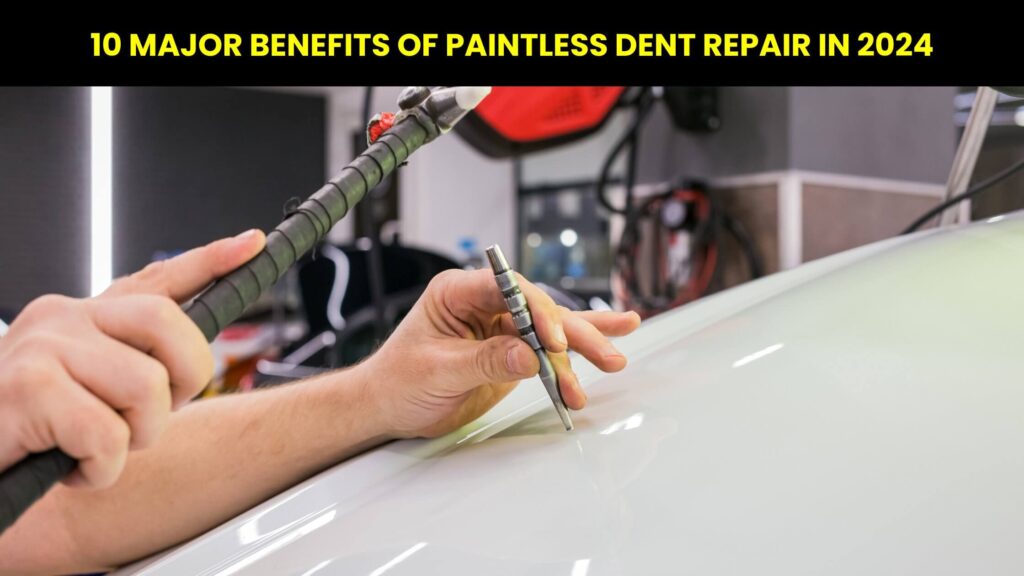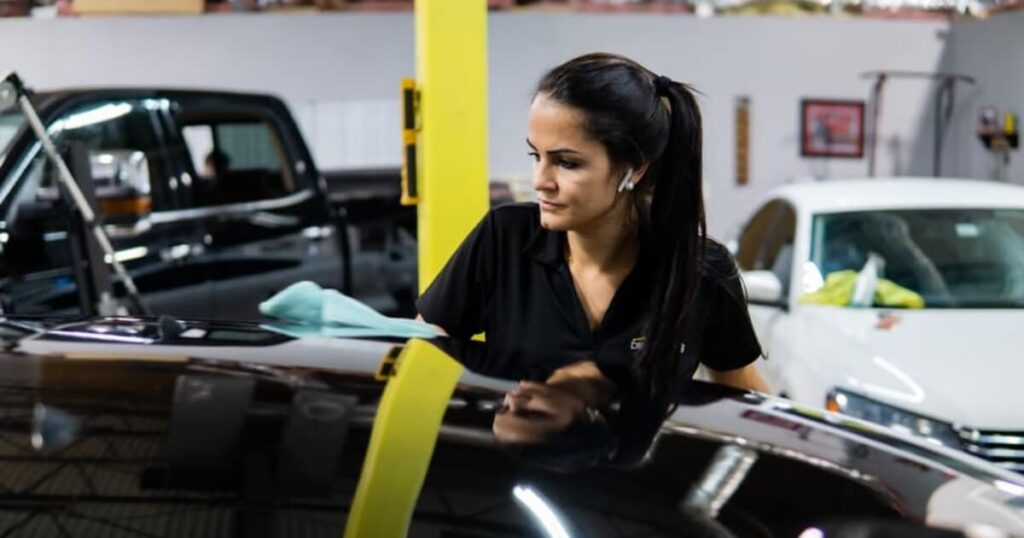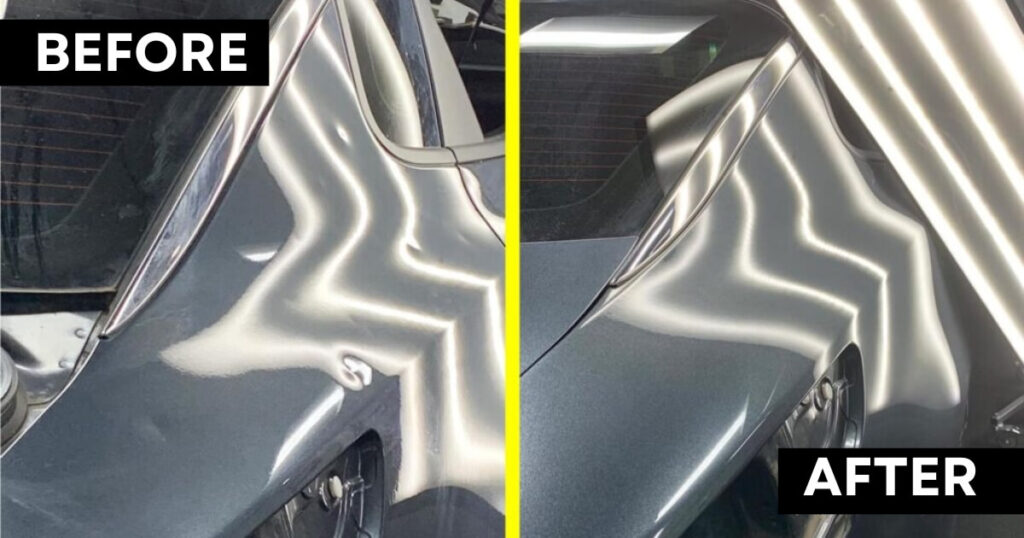What is Paintless Dent Repair?
Paintless Dent Repair, often called PDR, has become a prevalent method for removing minor dents and dings from vehicles without harming the original factory paint finish. This repair technique has revolutionized the automotive industry over the past few decades.
PDR provides car and truck owners with an affordable and convenient dent removal option that maintains a vehicle’s value and appearance better than conventional body shop repairs. Skilled PDR techs can make dings and creases disappear without repainting or replacing parts by carefully massaging out dents inside body panels.
A guide to Paintless dent repair for beginners with top ten compelling benefits that explain why Paintless Dent Repair has become the preferred method for fixing minor automotive dents and hail damage.
Top 10 Benefits of Paintless Dent Removal
Here’re the remarkable top 10 advantages of Paintless dent removal and restore your vehicle’s beauty with ease.
- Maintains the Original Factory Paint Finish
- Much More Affordable Than Conventional Repairs
- Much Faster Repair Times
- Maintains a Vehicle’s Resale Value
- Environmentally-Friendly Repair Process
- Prevents Vehicle Depreciation from Car Accidents
- Does Not Compromise a Vehicle’s Structural Integrity
- No Risk of Paint Color Mismatches or Noticeable Repairs
- Ideal for Repairing Hail Damage
- Protects Against Rust and Corrosion
1. Maintains the Original Factory Paint Finish
One of PDR’s most significant advantages over conventional dent repair methods is that it preserves a vehicle’s original factory paint finish. There is no need to repaint repaired panels or blend paint on adjacent body parts. The original paint color, texture, and luster remain untouched.
Paintless dent removal relies on gaining access behind the damaged body panel and gently manipulating the metal back into its original form. Specialized PDR tools and techniques allow techs to massage out dings and dents without scraping, puncturing, or harming the paint in any way.
For car and truck owners who want factory-perfect repairs, paintless dent removal provides a clear advantage over traditional repairs that involve sanding, body fillers, paint matching, and repainting. No paint or bodywork means no threat of paint color mismatches, noticeable paint lines, orange peel, or loss of the original finish’s clarity and depth.
2. Much More Affordable Than Conventional Repairs
Another major benefit of PDR is that it costs substantially less than traditional dent repair methods. Paintless dent removal is so much more affordable because no painting or replacement parts are involved.
Minor dings, door dents, and hail damage that may cost $500 or more to repair conventionally can often be fixed for under $200 with PDR techniques. Since techs are simply massaging out existing dents rather than welding in new metal panels or repainting from one panel to the next, it takes much less labor and materials to complete PDR repairs.
For minor dings and dents, paintless dent removal is often priced competitively with SMART repairs. However, PDR can generally fix much larger damage than SMART repairs can handle without repainting. When considering that a primary paint job can easily cost $1000 or more, PDR provides huge cost savings anytime repainting can be avoided.
3. Much Faster Repair Times
In addition to lower costs, PDR takes much less time to complete than traditional dent work. Paintless dent removal relies on specialized tools and meticulous hand movements rather than welding, bonding, sanding, and spraying paint.
In many cases, an experienced PDR technician can massage out minor dings and dents in as little as 10 to 20 minutes. More extensive hail damage may take a few hours to several days to fix with PDR techniques. This is still exponentially faster than traditional body shop methods that can tie up a vehicle for weeks.
The faster turnaround times with Paintless Dent Repair make it easier for owners to drop off vehicles for a few hours without disrupting their daily transportation needs. Speedier repairs also minimize the time customers spend managing rental cars and other inconveniences that come with more extensive body shop repairs.
4. Maintains a Vehicle’s Resale Value
Preserving a vehicle’s original factory paint finish maintains its resale value more than traditional dent repairs. Clean, original paint always helps cars and trucks retain a higher value than ones with bodywork and repainting.
For owners looking to repair minor cosmetic defects before selling their vehicle, Paintless Dent Repair provides fast, affordable repairs that buyers are less likely to notice during a test drive. Even extensive PDR hail damage repairs help vehicles retain more excellent value than conventional repairs by keeping all body panels in factory original condition.
Leaving the original finish intact can make PDR repairs nearly invisible to future owners. This allows vehicles to command higher resale prices by looking cleaner and more original than with body fillers and repainting.
5. Environmentally-Friendly Repair Process
Paintless Dent Repair is much better for the environment than conventional collision repair methods. It eliminates the need for hazardous automotive paints and primers, chemical paint strippers and thinners, body fillers loaded with VOC compounds, and repainting operations that generate paint overspray and other waste.
The carbon footprint of PDR repairs is exponentially lower than traditional repairs that rely heavily on VOC-emitting paint products and processes. The green repair approach makes PDR attractive for eco-conscious consumers looking to minimize environmental impacts. It also helps automotive businesses reduce regulatory burdens and overhead costs related to waste disposal and emissions compliance.
6. Prevents Vehicle Depreciation from Car Accidents
Minor automotive accidents that result in door dings, fender creases, and hood dents can significantly depreciate a vehicle’s value even after repairs are completed. This is especially true when repairs require body fillers, sanding, and repainting rather than Paintless Dent Repair techniques.
Significant depreciation occurs because bodywork and repainting due to collisions ultimately change a vehicle’s original condition and appearance, even when repairs are done correctly. Buyers are generally willing to pay less for vehicles with collision damage than comparable cars and trucks with clean original paint.
PDR repairs that avoid harming or altering the OEM paint finish help maintain more of a vehicle’s pre-accident value. Insurance PDR and hail damage repair work can also save vehicles from depreciating, like if covered with body filler and repainting.
7. Does Not Compromise a Vehicle’s Structural Integrity
Conventional collision repairs often involve cutting out and welding in new sheet metal panels to fix damage. This puts holes in original body panels that can compromise a vehicle’s structural integrity over time as rust forms around weld sites. Pulling or hammering out dents with brute force can also unintentionally bend or warp factory sheet metal panels.
Paintless Dent Repair focuses strictly on gently coaxing body panels back into their original form without welding, grinding, drilling, or damage to the underlying structure. PDR even avoids putting any unnecessary heat into panels that could alter the properties of factory sheet metal. This preserves the engineered crumple zones, stability, and safety cell integrity of vehicle makers initially built into the body structure.
8. No Risk of Paint Color Mismatches or Noticeable Repairs
Traditional dent repairs often mismatch some paint color between new paint in repaired areas and the original surrounding finish. Blending paint from one panel to the next is rarely invisible after it ages and weathers at different rates than the factory paintwork.
If body filler was used instead of welding in new metal panels, those areas may eventually sink in over time, and become visible. They also appear differently than factory metal under a magnet during vehicle inspections.
Paintless Dent Repair avoids all these risks involved with repainting collision damage. Factory paint color, texture, and depth remain uniform across panels for a seamless appearance. With no bodywork or repainting, PDR repairs are virtually undetectable, even under close inspection or magnetic validation.
9. Ideal for Repairing Hail Damage
Paintless Dent Repair techniques were originally developed to remove hail damage from vehicle body panels. The tools and meticulous pushing methods PDR techs use are uniquely suited for smoothing out shallow dimples and dings produced by hail strikes.
Trying to fix hail damage with conventional body shop methods would involve more extensive panel replacement, glazing putty, primer, and paintwork. PDR allows damaged panels to be fixed quickly without any intrusive repairs.
Insurance companies now regularly specify PDR hail repair for policyholder claims because it provides an efficient, cost-effective way to restore heavily pelted vehicle bodies to pre-storm condition. PDR makes it feasible to repair hundreds or even thousands of hail dings that would otherwise total many vehicles.
10. Protects Against Rust and Corrosion
Lastly, preserving the integrity of a vehicle’s original factory paint finish provides critical protection against rust and corrosion. Whenever body panels get sanded, it removes the primer, paint, and clearcoat layers that protect the underlying raw metal from oxidation.
With PDR, the factory rustproofing on panels remains completely intact. This maintains the maximum corrosion resistance vehicle makers engineer into their products.
Any time paint is damaged to bare metal from collisions or other causes, it opens up those areas to collect moisture and accelerates rust formation. Paintless dent removal avoids unnecessary breaching of the OEM corrosion protection in comparison to conventional repairs.
The Paintless Dent Repair Process
Now that you understand all the significant advantages PDR offers consumers, it helps to learn more about the Paintless Dent Repair process and how technicians can remove dents while keeping the original factory paint finish untouched.
How Paintless Dent Repair Technicians Access Behind-Body Panels
The first step with any PDR repair is gaining access to the backside of the damaged body panel. Technicians use various methods to open up sufficient space to reach behind the dent and apply their specialized tools.
For door dings and other dents on bolt-on exterior body panels, techs can remove the damaged part. This allows full access to manipulate the dent from behind. For panels like hoods, roofs, and rear quarters that cannot be unbolted, technicians rely on natural openings or create new access points.
On door panels, techs typically remove interior door trim panels to access dents through the inner door shell. For roof dents, interior headliners get removed to open space between the roof panel and sheet metal bracing underneath. Quarter panels get accessed by folding down the rear seats and interior trim.
PDR techs must create temporary access points for body parts without ready access from behind. This generally involves drilling small holes through superficial layers behind or near the dent. Holes get punched through parts like trunk floors, rear seat back panels, tail light housings, bumper covers, etc.
These access holes allow hand tools and light wands to reach behind outer body panels and apply pressure from the inside. Holes drilled for PDR access are made as small and unobtrusive as possible. Once repairs are finished, techs reseal each access point so they become virtually invisible.
Using Specialized Tools to Manipulate the Metal
With proper access gained behind the damaged panel, PDR technicians use various specialized tools to coax the dented metal back into shape gently. Most of these tools consist of thin metal or plastic rods with rounded tips that apply pressure inside panels.
Different tip shapes allow pressure to be directed in specific ways for the most effective dent manipulation. Technicians may use multiple long rods or move a single one to various positions as needed to massage out damages. Other standard PDR tools include version tabs, bridge pulls, and whiz pins.
PDR technicians rely on feel and experience rather than sight to work dents back into alignment carefully. Lifting metal too aggressively can stretch or warp panels, so the process involves gradually easing it back to form. Some techs use items like dry ice behind panels to shrink metal before pushing other areas. Gentle heat may be applied to help relax and expand stubborn creases.
Using Lights to Identify High and Low Spots
To pinpoint problem spots and monitor their progress, PDR techs use specialized light wands and reflection boards. Bright LED light wands can be maneuvered at various angles behind panels. This creates reflection patterns on the paint that clearly show high and low spots as the light bends across them.
As the technician pushes on high spots and creases from behind, the changing light patterns immediately show when alignment improves, or more work is needed. The lights help techs work systematically across each dent, guiding the metal into form with their tools rather than guessing.
Tapping Down Dents from Above
Light tapping is used to bump out dents from above for areas a technician cannot reach from behind or where an exterior impact left the metal pushed in. Specialized PDR hammers and taps allow precision tapping that gently pushes metal up without damaging the paint.
Tapping works well for fixing minor dings, like those left by errant shopping carts in parking lots. It helps create enough relief for creased edges to be massaged from behind the panel. The tapping also counters any deformities caused by exterior impacts.
Gleaming the Paint Surface
Once PDR work eliminates all signs of a dent, technicians perform final paint refinement to restore the surface’s original glossy finish. This involves “claying” the paint to remove overspray or bonded surface contaminants. A buffing compound is then applied using a rotary polisher.
The gentle buffing helps smooth out any micro-high spots or texture changes left behind in the paint film from the original dent. It erases light scratches and restores a uniform surface luster across the repaired panel. This helps make repairs virtually invisible.
PDR Maintenance and Care
To keep your vehicle looking its best after Paintless Dent Repairs, follow these simple maintenance tips:
Keep the Paint Surface Clean
Regularly wash your vehicle to prevent dirt buildup that can dull the paint’s glossy finish. Use a clean microfiber cloth with car wash soap and water. Rinse thoroughly. Wax or sealant helps protect the finish. Avoid using dish soap or harsh cleaners.
Inspect for New Chips and Scratches
Make a habit of walking around and inspecting freshly washed vehicles to catch any new paint chips or scratches. Addressing them quickly prevents further damage. Maintain a small touch-up paint pen to fill in any minor imperfections.
Avoid Parking around Loose Shopping Carts
Watch where you park at supermarkets, department stores, and shopping malls. Avoid spots next to loose carts that can dent doors and quarter panels when pushed by the wind or other shoppers. The minor dings shopping carts create are easy PDR fixes but best avoided.
Use Door Protection Parking Blockers
Invest in soft foam door protection parking blocks or pads attached to parking space markings. They cushion vehicle doors from dings when opening in tight parking spaces. Just remember to remove them before driving off.
Move Vehicles Under Cover during Storms
Relocate any vehicles parked outdoors into covered garage spaces whenever severe thunderstorms threaten. Hail can suddenly pelt exposed panels, requiring extensive PDR repairs to fix multiple impacts. Overhead shelter prevents hail damage.
Handle Repaired Areas Normally
Do not feel you need to baby or avoid contacting areas fixed via Paintless Dent Repair. Once PDR work eliminates dents, the panel integrity and durability return to normal factory condition. Dinged or repaired panels withstand regular use and car washes without issue.
Conclusion
In conclusion, Paintless dent repair provides numerous benefits over traditional body shop repair methods that involve painting. PDR keeps the factory paint intact, avoiding the need to wet sand and buff out any imperfections from a repaint. This results in a repair that looks completely invisible once finished. Customers appreciate how PDR saves them time since no disassembly or mask-up of vehicles is needed.
Money is also saved through PDR, as the process costs a fraction of repainting. Body shops like the efficiency of PDR since technicians can repair multiple dents per day. When done by a certified paintless dent repair Dallas expert, the quality and precision are on par with the factory. As the technology has advanced, even larger and more severe dents that were previously impossible can now be removed through PDR.
With minor dent and ding repairs taking just 30 minutes instead of days in the body shop, paintless dent repair provides numerous convenience benefits to customers in the Dallas, TX, area. It preserves a vehicle’s factory look and value while delivering quick repairs at affordable prices. PDR continues to grow in popularity as more drivers discover its many advantages over traditional body work involving painting.



